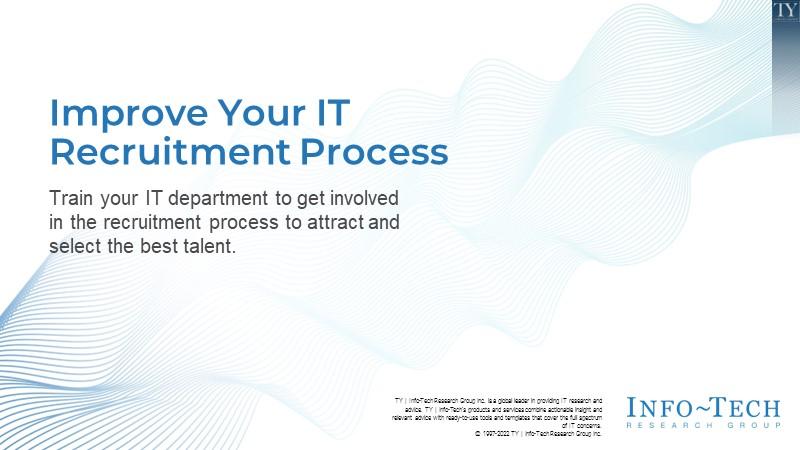
Improve Your IT Recruitment Process
Business and IT leaders aiming to recruit and select the best talent need to:
- Get involved in the talent acquisition process at key moments.
- Market their organization to top talent through an authentic employer brand.
- Create engaging and accurate job ads.
- Leverage purposeful sourcing for anticipated talent needs.
- Effectively assess candidates with a strong interview process.
- Set up new employees for success.
Our Advice
Critical Insight
To create a great candidate experience, IT departments must be involved in the process at key points, recruitment and selection is not a job for HR alone!
Impact and Result
- Use this how-to guide to articulate an authentic (employee value proposition) EVP and employer brand.
- Perform an analysis of current sourcing methods and build an action plan to get IT involved.
- Create an effective and engaging job ad to insure the right people are applying.
- Train hiring managers to effectively deliver interviews that correctly assess candidate suitability.
- Get links to in-depth Info-Tech resources and tools.
Improve Your IT Recruitment Process Research & Tools
Besides the small introduction, subscribers and consulting clients within this management domain have access to:
1. Improve Your IT Recruitment Process – A guide to help you attract and select the best talent.
Train your IT department to get involved in the recruitment process to attract and select the best talent.
- Improve Your IT Recruitment Process Capstone Deck
2. Improve Your IT Recruitment Process Workbook – A tool to document your action plans.
Use this tool in conjunction with the Improve you IT Recruitment Process to document your action plans
- Improve Your IT Recruitment Process Workbook
3. Interview Guide Template – A template to organize interview questions and their rating scales, take notes during the interview, and ensure all interviews follow a similar structure.
To get useful information from an interview, the interviewer should be focused on what candidates are saying and how they are saying it, not on what the next question will be, what probes to ask, or how they will score the responses. This Interview Guide Template will help interviewers stay focused and collect good information about candidates.
- Interview Guide Template
4. IT Behavioral Interview Question Library – A tool that contains a complete list of sample questions aligned with core, leadership, and IT competencies.
Hiring managers can choose from a comprehensive collection of core, functional, and leadership competency-based behavioral interview questions.
- IT Behavioral Interview Question Library
5. Job Ad Template – A template to allow complete documentation of the characteristics, responsibilities, and requirements for a given job posting in IT.
Use this template to develop a well-written job posting that will attract the star candidates and, in turn, deflect submission of irrelevant applications by those unqualified.
- Job Ad Template
6. Idea Catalog – A tool to evaluate virtual TA solutions.
The most innovative technology isn’t necessarily the right solution. Review talent acquisition (TA) solutions and evaluate the purpose each option serves in addressing critical challenges and replacing critical in-person activities.
- Idea Catalog: Adapt the Talent Acquisition Process to a Virtual Environment
Workshop: Improve Your IT Recruitment Process
Workshops offer an easy way to accelerate your project. If you are unable to do the project yourself, and a Guided Implementation isn't enough, we offer low-cost delivery of our project workshops. We take you through every phase of your project and ensure that you have a roadmap in place to complete your project successfully.
1 Employee Value Proposition and Employer Branding
The Purpose
Establish the employee value proposition (EVP) and employer brand.
Key Benefits Achieved
Have a well-defined EVP that you communicate through your employer brand.
Activities
1.1 Gather feedback.
1.2 Build key messages.
1.3 Assess employer brand.
Outputs
Content and themes surrounding the EVP
Draft EVP and supporting statements
A clearer understanding of the current employer brand and how it could be improved
2 Job Ads and Sourcing
The Purpose
Develop job postings and build a strong sourcing program.
Key Benefits Achieved
Create the framework for an effective job posting and analyze existing sourcing methods.
Activities
2.1 Review and update your job ads.
2.2 Review the effectiveness of existing sourcing programs.
2.3 Review job ads and sourcing methods for bias.
Outputs
Updated job ad
Low usage sourcing methods identified for development
Minimize bias present in ads and sourcing methods
3 Effective Interviewing
The Purpose
Create a high-quality interview process to improve candidate assessment.
Key Benefits Achieved
Training on being an effective interviewer.
Activities
3.1 Create an ideal candidate scorecard.
3.2 Map out your interview process.
3.3 Practice behavioral interviews.
Outputs
Ideal candidate persona
Finalized interview and assessment process
Practice interviews
4 Onboarding and Action Plan
The Purpose
Drive employee engagement and retention with a robust program that acclimates, guides, and develops new hires.
Key Benefits Achieved
Evaluation of current onboarding practice.
Activities
4.1 Evaluate and redesign the onboarding program.
Outputs
Determine new onboarding activities to fill identified gaps.
Further reading
Improve Your IT Recruitment Process
Train your IT department to get involved in the recruitment process to attract and select the best talent.
Own the IT recruitment process
Train your IT department to get involved in the recruitment process to attract and select the best talent.
Follow this blueprint to:
- Define and communicate the unique benefits of working for your organization to potential candidates through a strong employer brand.
- Learn best practices around creating effective job postings.
- Target your job posting efforts on the areas with the greatest ROI.
- Create and deliver an effective, seamless, and positive interview and offer process for candidates.
- Acclimate new hires and set them up for success.
Get involved at key moments of the candidate experience to have the biggest impact
|
|
Effective Interviewing |
Onboarding: Setting up New Hires For Success |
|||||||||
| Awareness | → | Research | → | Application | → | Screening | → | Interview and Assessment | → | Follow Up | → | Onboarding |
RECRUIT QUALITY STAFF
Hiring talent is critical to organizational success
Talent is a priority for the entire organization:
Respondents rated “recruitment” as the top issue facing organizations today (McLean & Company 2022 HR Trends Report).
37% of IT departments are outsourcing roles to fill internal skill shortages (Info-Tech Talent Trends 2022 Survey).
Yet bad hires are alarmingly common:
Hiring is one of the least successful business processes, with three-quarters of managers reporting that they have made a bad hire (Robert Half, 2021).
48% of survey respondents stated improving the quality of hires was the top recruiting priority for 2021 (Jobvite, 2021).
Workshop overview
Prework |
Day 1 |
Day 2 |
Day 3 |
Day 4 |
Post work |
|
|---|---|---|---|---|---|---|
Current Process and Job Descriptions Documented |
Establish the Employee Value Proposition (EVP) and Employer Brand |
Develop Job Postings and Build a Strong Sourcing Program |
Effective Interviewing |
Onboarding and Action Planning |
Putting the Action Plan Into Action! |
|
Activities |
|
1.1 Introduce the Concept of an EVP 1.2 Brainstorm Unique Benefits of Working at Your Organization 1.2 Employer Brand Introduction |
2.1 What Makes an Attractive Job Posting 2.2 Create the Framework for Job Posting 2.3 Improve the Sourcing Process 2.4 Review Process for Bias |
3.1 Creating an Interview Process 3.2 Selecting Interview Questions 3.3 Avoiding Bias During Interviews 3.4 Practice Interviews |
4.1 Why Onboarding Matters 4.2 Acclimatize New Hires and Set Them Up for Success 4.3 Action Plan |
5.1 Review Outputs and Select Priorities 5.2 Consult With HR and Senior Management to Get Buy-In 5.3 Plan to Avoid Relapse Behaviors |
Deliverables |
|
|
|
|
Enhance Your Recruitment Strategies
The way you position the organization impacts who is likely to apply to posted positions.
Develop a strong employee value proposition
What is an employee value proposition?
And what are the key components?
The employee value proposition is your opportunity to showcase the unique benefits and opportunities of working at your organization, allowing you to attract a wider pool of candidates.
AN EMPLOYEE VALUE PROPOSITION IS: |
AN EMPLOYEE VALUE PROPOSITION IS NOT: |
||
|
|
||
THE FOUR KEY COMPONENTS OF AN EMPLOYEE VALUE PROPOSITION |
|||
Rewards |
Organizational Elements |
Working Conditions |
Day-to-Day Job Elements |
|
|
|
|
Creating a compelling EVP that presents a picture of your employee experience, with a focus on diversity, will attract a wide pool of diverse candidates to your team. This can lead to many internal and external benefits for your organization.
How to collect information on your EVP
Existing Employee Value Proposition: If your organization or IT department has an existing employee value proposition, rather than starting from scratch, we recommend leveraging that and moving to the testing phase to see if the EVP still resonates with staff and external parties.
Employee Engagement Results: If your organization does an employee engagement survey, review the results to identify the areas in which the IT organization is performing well. Identify and document any key comment themes in the report around why employees enjoy working for the organization or what makes your IT department a great place to work.
Social Media Sites. Prepare for the good, the bad, and the ugly. Social media websites like Glassdoor and Indeed make it easier for employees to share their experiences at an organization honestly and candidly. While postings on these sites won’t relate exclusively to the IT department, they do invite participants to identify their department in the organization. You can search these to identify any positive things people are saying about working for the organization and potentially opportunities for improvement (which you can use as a starting point in the retention section of this report).
1.1 Gather feedback
- Download the Improve Your IT Recruitment Workbook.
- On tab 1.1, brainstorm the top five things you value most about working at the organization. Ask yourself what would fall in each category and identify any key themes. Be sure to take note of any specific quotes you have.
- Brainstorm limitations that the organization currently has in each of those areas.
Download the Recruitment Workbook
Input |
Output |
|
|
Materials |
Participants |
|
|
1.2 Build key messages
- Go to tab 1.2 in your workbook
- Identify themes from activity 1.1 that would be considered current strengths of you organization.
- Identify themes from activity 1.2 that are aspirational elements of your organization.
- Identify up to four key statements to focus on for the EVP, ensuring that your EVP speaks to at least one of the five categories above.
- Integrate these into one overall statement.
Examples below.
Input | Output |
|
|
Materials | Participants |
|
|
Sample EVPs
Shopify |
“We’re Shopify. Our mission is to make commerce better for everyone – but we’re not the workplace for everyone. We thrive on change, operate on trust, and leverage the diverse perspectives of people on our team in everything we do. We solve problems at a rapid pace. In short, we get shit done.” |
|---|---|
Bettercloud |
“At Bettercloud, we have a smart, ambitious team dedicated to delighting our customers. Our culture of ownership and transparency empowers our team to achieve goals they didn’t think possible. For all those on board, it’s going to be a challenging and rewarding journey – and we’re just getting started.” |
Ellevest |
“As a team member at Ellevest, you can expect to make a difference through your work, to have a direct impact on the achievement of a very meaningful mission, to significantly advance your career trajectory, and to have room for fun and fulfillment in your daily life. We know that achieving a mission as critical as ours requires incredible talent and teamwork, and team is the most important thing to us.” |
Sources: Built In, 2021; Workology, 2022
Ensure your EVP resonates with employees and prospects
Test your EVP with internal and external audiences.
INTERNAL TEST REVOLVES AROUND THE 3A’s |
EXTERNAL TEST REVOLVES AROUND THE 3C’s |
|---|---|
ALIGNED: The EVP is in line with the organization’s purpose, vision, values, and processes. Ensure policies and programs are aligned with the organization’s EVP. |
CLEAR: The EVP is straightforward, simple, and easy to understand. Without a clear message in the market, even the best intentioned EVPs can be lost in confusion. |
ACCURATE: The EVP is clear and compelling, supported by proof points. It captures the true employee experience, which matches the organization’s communication and message in the market. |
COMPELLING: The EVP emphasizes the value created for employees and is a strong motivator to join this organization. A strong EVP will be effective in drawing in external candidates. The message will resonate with them and attract them to your organization. |
ASPIRATIONAL: The EVP inspires both individuals and the IT organization as a whole. Identify and invest in the areas that are sure to generate the highest returns for employees. |
COMPREHENSIVE: The EVP provides enough information for the potential employee to understand the true employee experience and to self-assess whether they are a good fit for your organization. If the EVP lacks depth, the potential employee may have a hard time understanding the benefits and rewards of working for your organization. |
Want to learn more?
Recruit IT Talent
- Improve candidate experience to hire top IT talent.
Recruit and Retain More Women in IT
- Gender diversity is directly correlated to IT performance.
Recruit and Retain People of Color in IT
- Good business, not just good philanthropy.
Enhance Your Recruitment Strategies
The way you position the organization impacts who is likely to apply to posted positions.
Market your EVP to potential candidates: Employer Brand
Employer brand includes how you market the EVP internally and externally – consistency is key
The employer brand is the perception internal and external stakeholders hold of the organization and exists whether it has been curated or not. Curating the employer brand involves marketing the organization and employee experience. Grounding your employer brand in your EVP enables you to communicate and market an accurate portrayal of your organization and employee experience and make you desirable to both current and potential employees.
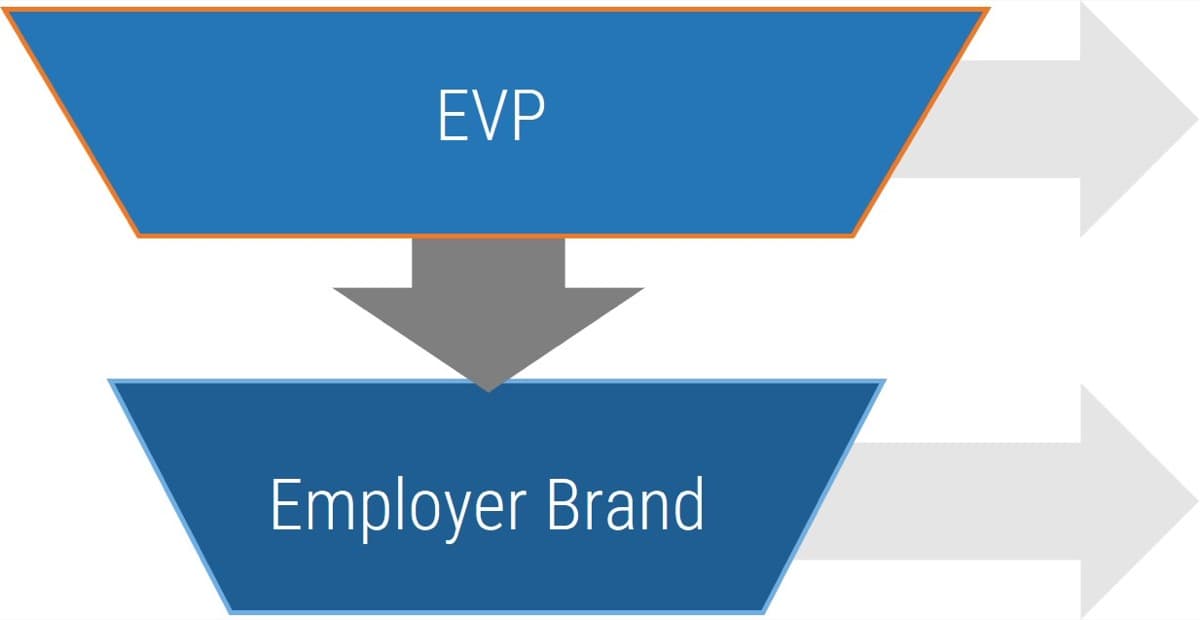 |
The unique offering an employer provides to employees in return for their effort, motivating them to join or remain at the organization. The perception internal and external stakeholders hold of the organization. |
Alignment between the EVP, employer brand, and corporate brand is the ideal branding package. An in-sync marketing strategy ensures stakeholders perceive and experience the brand the same way, creating brand ambassadors.
Ensure your branding material creates a connection
How you present your employer brand is just as important as the content. Ideally, you want the viewer to connect with and personalize the material for the message to have staying power. Use Marketing’s expertise to help craft impactful promotional materials to engage and excite the viewer.
Visuals
Images are often the first thing viewers notice. Use visuals that connect to your employer brand to engage the viewer’s attention and increase the likelihood that your message will resonate. However, if there are too many visuals this may detract from your content – balance is key!
Language
Wordsmithing is often the most difficult aspect of marketing. Your message should be accurate, informative, and engaging. Work with Marketing to ensure your wording is clever and succinct – the more concise, the better.
Composition
Integrate visuals and language to complete your marketing package. Ensure that the text and images are balanced to draw in the viewer.
Case Study: Using culture to drive your talent pool
This case study is happening in real time. Please check back to learn more as Goddard continues to recruit for the position.
Recruiting at NASA
Goddard Space Center is the largest of NASA’s space centers with approximately 11,000 employees. It is currently recruiting for a senior technical role for commercial launches. The position requires consulting and working with external partners and vendors.
NASA is a highly desirable employer due to its strong culture of inclusivity, belonging, teamwork, learning, and growth. Its culture is anchored by a compelling vision, “For the betterment of Humankind,” and amplified by a strong leadership team that actively lives their mission and vision daily.
Firsthand lists NASA as #1 on the 50 most prestigious internships for 2022.
Rural location and no flexible work options add to the complexity of recruiting
The position is in a rural area of Eastern Shore Virginia with a population of approximately 60,000 people, which translates to a small pool of candidates. Any hire from outside the area will be expected to relocate as the senior technician must be onsite to support launches twice a month. Financial relocation support is not offered and the position is a two-year assignment with the option of extension that could eventually become permanent.

“Looking for a Talent Unicorn: a qualified, experienced candidate with both leadership skills and deep technical expertise that can grow and learn with emerging technologies.”
Steve Thornton
Acting Division Chief, Solutions Division, Goddard Space Flight Center, NASA
Case Study: Using culture to drive your talent pool
A good brand overcomes challenges.
Culture takes the lead in NASA's job postings, which attract a high number of candidates. Postings begin with a link to a short video on working at NASA, its history, and how it lives its vision. The video highlights NASA's diversity of perspectives, career development, and learning opportunities.
NASA's company brand and employer brand are tightly intertwined, providing a consistent view of the organization.
The employer vision is presented in the best place to reach NASA's ideal candidate: usajobs.gov, the official website of the United States Government and the “go-to” for government job listings. NASA also extends its postings to other generic job sites as well as LinkedIn and professional associations.

Interview with Robert Leahy
Chief Information Officer, Goddard Space Flight Center, NASA
2.1 Assess your organization’s employer brand
- Go to tab 2.1 in the Improve Your IT Recruitment Workbook.
- Put yourself in the shoes of someone on the outside looking in. If they were to look up your organization, what impression would they be given about what is like to work there?
- Run a Google search on your organization with key words “jobs,” “culture,” and “working environment” to see what a potential candidate would see when they begin researching your organization.
You can use sites like:
- Glassdoor
- Indeed company pages
- LinkedIn company pages
- Social media
- Your own website
| Input | Output |
|
|
| Materials | Participants |
|
|
Want to learn more?
Recruit IT Talent
- Improve candidate experience to hire top IT talent.
Recruit and Retain More Women in IT
- Gender diversity is directly correlated to IT performance.
Recruit and Retain People of Color in IT
- Good business, not just good philanthropy.
Enhance Your Recruitment Strategies
The way you position the organization impacts who is likely to apply to posted positions.
Create engaging job ads to attract talent to the organization
We have a job description; can I just post that on Indeed?
A job description is an internal document that includes sections such as general job information, major responsibilities, key relationships, qualifications, and competencies. It communicates job expectations to incumbents and key job data to HR programs.
A job ad is an externally facing document that advertises a position with the intent of attracting job applicants. It contains key elements from the job description as well as information on the organization and its EVP.
Write an Effective Job Ad
- Ensure that your job ad speaks to the audience you are targeting through the language you use.
- E.g. If you are hiring for a creative role, use creative language and formatting. If you are writing for students, emphasize growth opportunities.
- Highlight the organization’s EVP.
- Paint an accurate picture of key aspects of the role but avoid the nitty gritty as it may overwhelm applicants.
- Link to your organization’s website and social media platforms so applicants can easily find more information.
A job description informs a job ad, it doesn’t replace it. Don’t be lulled into using a job description as a posting when there’s a time crunch to fill a position. Refer to job postings as job advertisements to reinforce that their purpose is to attract attention and talent.
An effective job posting contains the following elements:
| Position Title |
|
|---|---|
| Company |
|
| Summary Description |
|
| Responsibilities |
|
| Position Characteristics |
|
| Position Requirements |
|
| Work Conditions |
|
| Process to Apply |
|
Bottom Line: A truly successful job posting ferrets out those hidden stars that may be over cautious and filters out hundreds of applications from the woefully under qualified.
The do’s and don’ts of an inclusive job ad
DON’T overlook the power of words. Avoid phrases like “strong English language skills” as this may deter non-native English speakers from applying and a “clean-shaven” requirement can exclude candidates whose faith requires them to maintain facial hair. DON’T post a long requirements list. A study showed that the average jobseeker spends only 49.7 seconds reviewing a listing before deciding it's not a fit.* DON’T present a toxic work culture; phrases such as “work hard, play hard” can put off many candidates and play into the “bro- culture” stereotype in tech. |
Position Title: Senior Lorem Ipsum Salary Band: $XXX to $XXX Diversity is a core value at ACME Inc. We believe that diversity and inclusion is our strength, and we’re passionate about building an environment where all employees are valued and can perform at their best. As a … you will … Our ideal candidate …. Required Education and Experience
Required Skills
Preferred Skills
At ACME Inc. you will find … |
DO promote pay equity by being up front and honest about salary expectations. DO emphasize your organization’s commitment to diversity and an inclusive workplace by adding an equity statement. DO limit your requirements to “must haves” or at least showcase them first before the “nice-to-haves.” DO involve current employees or members of your employee resource groups when creating job descriptions to ensure that they ask for what you really need. DO focus on company values and criteria that are important to the job, not just what’s always been done. |
*Source: Ladders, 2013
Before posting the job ad complete the DEI job posting validation checklist
| ☑ | Does the job posting highlight your organization’s EVP |
| ☐ | Does the job posting avoid words that might discourage women, people of color, and other members of underrepresented groups from applying? |
| ☑ | Has the position description been carefully reviewed and revised to reflect current and future expectations for the position, rather than expectations informed by the persons who have previously held the job? |
| ☐ | Has the hiring committee eliminated any unnecessary job skills or requirements (college degree, years or type of previous experience, etc.) that might negatively impact recruitment of underrepresented groups? |
| ☑ | Has the hiring committee posted the job in places (job boards, websites, colleges, etc.) where applicants from underrepresented groups will be able to easily view or access it? |
| ☐ | Have members of the hiring committee attended job fairs or other events hosted by underrepresented groups? |
| ☐ | Has the hiring committee asked current employees from underrepresented groups to spread the word about the position? |
| ☐ | Has the hiring committee worked with the marketing team to ensure that people from diverse groups are featured in the organization’s website, publications, and social media? |
| ☐ | es the job description clearly demonstrate the organization’s and leadership’s commitment to DEI? |
*Source: Recruit and Retain People of Color in IT
3.1 Review and update your job ads
- Download the Job Ad Template.
- Look online or ask HR for an example of a current job advertisement you are using.
- If you don’t have one, you can use a job description as a starting point.
| Input | Output |
|
|
| Materials | Participants |
|
|
Want to learn more?
Recruit IT Talent
- Improve candidate experience to hire top IT talent.
Recruit and Retain More Women in IT
- Gender diversity is directly correlated to IT performance.
Recruit and Retain People of Color in IT
- Good business, not just good philanthropy.
Enhance Your Recruitment Strategies
Focus on key programs and tactics to improve the effectiveness of your sourcing approach.
Get involved with sourcing to get your job ad seen
To meet growing expectations, organizations need to change the way they source
Social Media |
Social media has trained candidates to expect:
|
While the focus on the candidate experience is important throughout the talent acquisition process, social media, technology, and values have made it a critical component of sourcing. |
Technology |
Candidates expect to be able to access job ads from all platforms.
Job ads must be clear, concise, and easily viewed on a mobile device. |
|
Candidate Values |
Job candidate’s values are changing.
Authenticity remains important.
|
Focus on key programs and tactics to improve the effectiveness of your sourcing approach
Internal Talent Mobility (ITM) Program
Social Media Program
Employee Referral Program
Alumni Program
Campus Recruiting Program
Other Sourcing Tactics
Take advantage of your current talent with an internal talent mobility program
What is it?
Positioning the right talent in the right place, at the right time, for the right reasons, and supporting them appropriately.
Internal Talent Mobility (ITM) Program Social Media Program Employee Referral Program Alumni Program Campus Recruiting Program Other Sourcing Tactics | ITM program benefits:
Provide opportunities to develop professionally, whether in the current role or through promotions/lateral moves. Keep strong performers and high-potential employees committed to the organization. Address rapid change, knowledge drain due to retiring Baby Boomers, and frustration associated with time to hire or time to productivity. Reduce spend on talent acquisition, severance, time to productivity, and onboarding. Increase motivation and productivity by providing increased growth and development opportunities. Align with the organization’s offering and what is important to the employees from a development perspective. Support and develop employees from all levels and job functions. |
Leverage social media to identify and connect with talent
Internal Talent Mobility (ITM) Program Social Media Program Employee Referral Program Alumni Program Campus Recruiting Program Other Sourcing Tactics | What is it? The widely accessible electronic tools that enable anyone to publish and access information, collaborate on common efforts, and build relationships. Learning to use social media effectively is key to sourcing the right talent.
(Ku, 2021) | |
Benefits of social media:
| Challenges of social media: With the proliferation of social media and use by most organizations, social media platforms have become overcrowded. As a result:
| |
“It is all about how we can get someone’s attention and get them to respond. People are becoming jaded.”
– Katrina Collier, Social Recruiting Expert, The Searchologist
Reap the rewards of an employee referral program
Internal Talent Mobility (ITM) Program Social Media Program Employee Referral Program Alumni Program Campus Recruiting Program Other Sourcing Tactics | What is it? Employees recommend qualified candidates. If the referral is hired, the referring employee typically receives some sort of reward. Benefits of an employee referral program:
55% of organizations report that hiring a referral is less expensive that a non-referred candidate (Clutch, 2020). The average recruiting lifecycle for an employee referral is 29 days, compared with 55 days for a non referral (Betterup, 2022). 46% percent of employees who were referred stay at their organization for a least one year, compared to 33% of career site hires (Betterup, 2022). High performers are more likely to refer other high performers to an organization (The University of Chicago Press, 2019). |
Avoid the Like Me Bias: Continually evaluate the diversity of candidates sourced from the employee referral program. Unless your workforce is already diverse, referrals can hinder diversity because employees tend to recommend people like themselves.
Tap into your network of former employees
Internal Talent Mobility (ITM) Program Social Media Program Employee Referral Program Alumni Program Campus Recruiting Program Other Sourcing Tactics | What is it? An alumni referral program is a formalized way to maintain ongoing relationships with former employees of the organization. Successful organizations use an alumni program:
Benefits of an alumni program:
|
Make use of a campus recruiting program
Internal Talent Mobility (ITM) Program Social Media Program Employee Referral Program Alumni Program Campus Recruiting Program Other Sourcing Tactics | What is it? A formalized means of attracting and hiring individuals who are about to graduate from schools, colleges, or universities. Almost 70% of companies are looking to employ new college graduates every year (HR Shelf, 2022). Campus recruitment benefits:
|
Info-Tech Insight
Target schools that align with your culture and needs. Do not just focus on the most prestigious schools: they are likely more costly, have more intense competition, and may not actually provide the right talent.
Identify opportunities to integrate non-traditional techniques
Internal Talent Mobility (ITM) Program Social Media Program Employee Referral Program Alumni Program Campus Recruiting Program Other Sourcing Tactics | 1. Professional industry associations
| 5. Not-for-profit intermediaries
| American Expresscreated a boot camp for software engineers in partnership with Year Up and Gateway Community College to increase entry-level IT hires. Results:
(HBR, 2016) |
2. Special interest groups
| 6. Gamification
| ||
3. Customers
| PwC (Hungary) created Multiploy, a two-day game that allows students to virtually experience working in accounting or consulting at the organization. Results:
(Zielinski, 2015) | ||
4. Exit interviews
|
Partner with other organizational functions to build skills and leverage existing knowledge
Use knowledge that already exists in the organization to improve talent sourcing capabilities.
Marketing |
HR |
|---|---|
Marketing knows how to:
|
HR knows how to:
|
To successfully partner with other departments in your organization:
- Acknowledge that they are busy. Like IT, they have multiple competing priorities.
- Present your needs and prioritize them. Create a list of what you are looking for and then be willing to just pick your top need. Work with the other department to decide what needs can and cannot be met.
- Present the business case. Emphasize how partnering is mutually beneficial. For example, illustrate to Marketing that promoting a strong brand with candidates will improve the organization’s overall reputation because often, candidates are customers.
- Be reasonable and patient. You are asking for help, so be moderate in your expectations and flexible in working with your partner.
Info-Tech Insight
Encourage your team to seek out, and learn from, employees in different divisions. Training sessions with the teams may not always be possible but one-on-one chats can be just as effective and may be better received.
5.1 Review the effectiveness of existing sourcing programs
- As a group review the description of each program as defined on previous slides. Ensure that everyone understands the definitions.
- In your workbook, look for the cell Internal Talent Mobility under the title; you will find five rows with the following
- This program is formally structured and documented.
- This program is consistently applied across the organization.
- Talent is sourced this way on an ad hoc basis.
- Our organization currently does not source talent this way.
- There are metrics in place to assess the effectiveness of this program.
| Input | Output |
|
|
| Materials | Participants |
|
|
Want to learn more?
Recruit IT Talent
- Improve candidate experience to hire top IT talent.
Recruit and Retain More Women in IT
- Gender diversity is directly correlated to IT performance.
Recruit and Retain People of Color in IT
- Good business, not just good philanthropy.
Enhance Your Recruitment Strategies
Interviews are the most often used yet poorly executed hiring tool.
Create a high-quality interview process to improve candidate assessment
Everyone believes they’re a great interviewer; self-assess your techniques, and “get real” to get better
If you…
- Believe everything the candidate says.
- Ask mostly hypothetical questions: "What would you do in a situation where…"
- Ask gimmicky questions: "If you were a vegetable, what vegetable would you be?"
- Ask only traditional interview questions: "What are your top three strengths?”
- Submit to a first impression bias.
- Have not defined what you are looking for before the interview.
- Ignore your gut feeling in an attempt to be objective.
- Find yourself loving a candidate because they are just like you.
- Use too few or too many interviewers in the process.
- Do not ask questions to determine the motivational fit of the candidate.
- Talk more than the interviewee.
- Only plan and prepare for the interview immediately before it starts.
…then stop. Use this research!
Most interviewers are not effective, resulting in many poor hiring decisions, which is costly and counter-productive
Most interviewers are not effective…
- 82% of organizations don’t believe they hire highly talented people (Trost, 2022).
- Approximately 76% of managers and HR representatives that McLean & Company interviewed agreed that the majority of interviewers are not very effective.
- 66% of hiring managers come to regret their interview-based hiring decisions (DDI, 2021).
…because, although everyone knows interviewing is a priority, most don’t make it one.
- Interviewing is often considered an extra task in addition to an employee’s day-to-day responsibilities, and these other responsibilities take precedence.
- It takes time to effectively design, prepare for, and conduct an interview.
- Employees would rather spend this time on tasks they consider to be an immediate priority.
Even those interviewers who are good at interviewing, may not be good enough.
- Even a good interviewer can be fooled by a great interviewee.
- Some interviewees talk the talk, but don’t walk the walk. They have great interviewing abilities but not the skills required to be successful in the specific position for which they are interviewing.
- Even if the interviewer is well trained and prepared to conduct a strong interview, they can get caught up with an interviewee that seems very impressive on the surface, and end up making a bad hire.
Preparing the Perfect Interview
Step 5: Define decision rights
Establish decision-making authority and veto power to mitigate post-interview conflicts over who has final say over a candidate’s status.
Follow these steps to create a positive interview experience for all involved.
Step 1: Define the ideal candidate profile; determine the attributes of the ideal candidate and their relative importance
Define the attributes of the ideal candidate…
Ideal candidate = Ability to do the job + Motivation to do the job + Fit |
|||
Competencies
|
|
|
|
Experiences
|
Data for these come from:
|
||
Data for these come from:
|
|||
Caution: Evaluating for “organizational or cultural fit” can lead to interviewers falling into the trap of the “like me” bias, and excluding diverse candidates.
…then determine the importance of the attributes.
Non-negotiable = absolutely required for the job! Usually attributes that are hard to train, such as writing skills, or expensive to acquire after hire, such as higher education or specific technical skills. |
An Asset Usually attributes that can be trained, such as computer skills. It’s a bonus if the new hire has it. |
Nice-to-have Attributes that aren’t necessary for the job but beneficial. These could help in breaking final decision ties. |
Deal Breakers: Also discuss and decide on any deal breakers that would automatically exclude a candidate. |
The job description is not enough; meet with stakeholders to define and come to a consensus on the ideal candidate profile
Definition of the Ideal Candidate
- The Hiring Manager has a plan for the new hire and knows the criteria that will best fulfill that mandate.
- The Executive team may have specific directives for what the ideal candidate should look like, depending on the level and critical nature of the position.
- Industry standards, which are defined by regulatory bodies, are available for some positions. Use these to identify skills and abilities needed for the job.
- Competitor information such as job descriptions and job reviews could provide useful data about a similar role in other organizations.
- Exit interviews can offer insight into the most challenging aspects of the job and identify skills or abilities needed for success.
- Current employees who hold the same or a similar position can explain the nuances of the day-to-day job and what attributes are most needed on the team.
“The hardest work is accurately defining what kind of person is going to best perform this job. What are their virtues? If you’ve all that defined, the rest is not so tough.”
– VP, Financial Services
Use a scorecard to document the ideal candidate profile and help you select a superstar
- Download the Workbook and go to tab 6.1.
- Document the desired attributes for each category of assessment: Competencies, Experiences, Fit, and Motivation. You can find an Attribute Library on the next tab.
- Rank each attribute by level of priority: Required, Asset, or Nice-to-Have.
- Identify deal breakers that would automatically disqualify a candidate from moving forward.
| Input | Output |
|
|
| Materials | Participants |
|
|
To identify questions for screening interviews, use the Screening Interview Template
A screening interview conducted by phone should have a set of common questions to identify qualified candidates for in-person interviews.
The Screening Interview Template will help you develop a screening interview by providing:
- Common screening questions that can be modified based on organizational needs and interview length.
- Establishing an interview team.
- A questionnaire format so that the same questions are asked of all candidates and responses can be recorded.
Once completed, this template will help you or HR staff conduct candidate screening interviews with ease and consistency. Always do screening interviews over the phone or via video to save time and money.
Info-Tech Insight
Determine the goal of the screening interview – do you want to evaluate technical skills, communication skills, attitude, etc.? – and create questions based on this goal. If evaluating technical skill, have someone with technical competency conduct the interview.
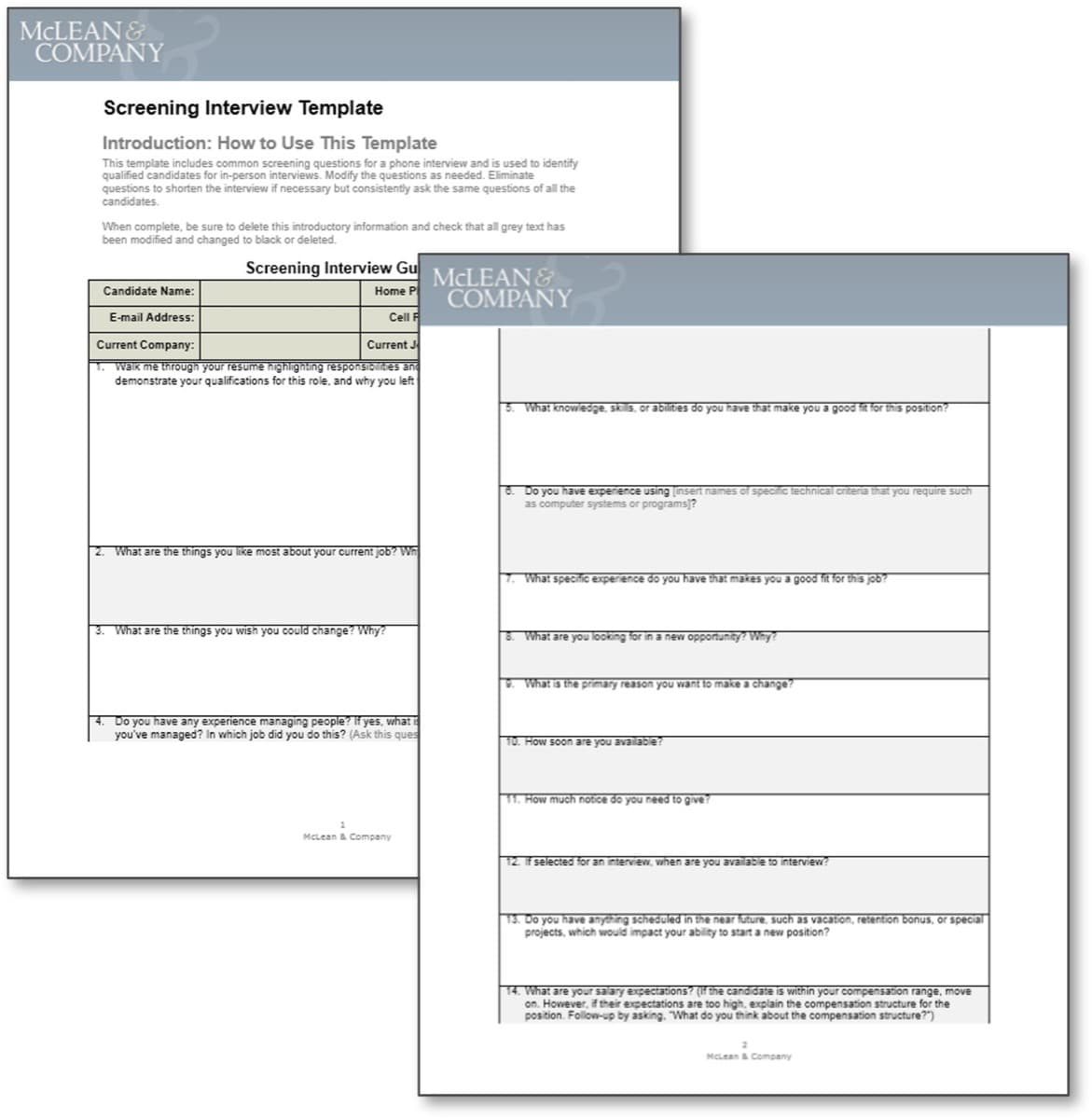
Step 2: Choose interview types and techniques that best assess the ideal candidate attributes listed on the position scorecard
There is no best interview type or technique for assessing candidates, but there could be a wrong one depending on the organization and job opening.
- Understanding common interviewing techniques and types will help inform your own interviewing strategy and interview development.
- Each interview technique and type has its own strengths and weakness and can be better suited for a particular organizational environment, type of job, or characteristic being assessed.

Unstructured: A traditional method of interviewing that involves no constraints on the questions asked, no requirements for standardization, and a subjective assessment of the candidate. This format is the most prone to bias. |
Semi-Structured: A blend of structured and unstructured, where the interviewer will ask a small list of similar questions to all candidates along with some questions pertaining to the resume. |
Structured: An interview consisting of a standardized set of job-relevant questions and a scoring guide. The goal is to reduce interviewer bias and to help make an objective and valid decision about the best candidate. |
No matter which interview types or techniques you use, aim for it to be as structured as possible to increase its validity
The validity of the interview increases as the degree of interview structure increases.
Components of a highly structured interview include:
- Interview questions are derived from a job analysis (they are job related).
- Interview questions are standardized (all applicants are asked the same questions).
- Prompting, follow-up questioning, probing, and/or elaboration on questions are limited. Try to identify all prompts, follow-ups, and probes beforehand and include them in the interview guide so that all candidates get the same level of prompting and probing.
- Interview questions focus on behaviors or work samples rather than opinions or self-evaluations.
- Interviewer access to ancillary information (e.g. resumes, letters of reference, test scores, transcripts) is controlled. Sometimes limiting access to these documents can limit interviewer biases.
- Questions from the candidate are not allowed until after the interview. This allows the interviewer to stay on track and not go off the protocol.
- Each answer is rated during the interview using a rating scale tailored to the question (this is preferable to rating dimensions at the end of the interview and certainly preferable to just making an overall rating or ranking at the end).
- Rating scales are “anchored” with behavioral examples to illustrate scale points (e.g. examples of a “1,” “3,” or “5” answer).
- Total interview score is obtained by summing across scores for each of the questions.
The more of these components your interview has, the more structured it is, and the more valid it will be.
Step 3: Prepare interview questions to assess the attributes you are looking for in a candidate
The purpose of interviewing is to assess, not just listen. Questions are what help you do this.
Preparing questions in advance allows you to:
- Match each question to a position requirement (included in your scorecard) to ensure that you assess all required attributes. Everything assessed should be job relevant!
- Determine each question’s weighting, if applicable.
- Give each candidate a chance to speak to all their job-relevant attributes.
- Keep records should an unselected candidate decide to contest the decision.
If you don’t prepare in advance:
- You’ll be distracted thinking about what you are going to ask next and not be fully listening.
- You likely won’t ask the same questions of all candidates, which impacts the ability to compare across candidates and doesn’t provide a fair process for everyone.
- You likely won’t ask the questions you need to elicit the information needed to make the right decision.
- You could ask illegal questions (see Acquire the Right Hires with Effective Interviewing for a list of questions not to ask in an interview).
Use the Interview Question Planning Guide tab in the Candidate Interview Strategy and Planning Guide to prepare your interview questions.
Use these tips to draft interview questions:
- Use job analysis output, in particular the critical incident technique, to develop structured interview questions.
- Search online or in books for example interview questions for the target position to inform interview question development. Just remember that candidates access these too, so be sure to ask for specific examples, include probing questions, and adapt or modify questions to change them.
- Situational questions: The situation should be described in sufficient detail to allow an applicant to visualize it accurately and be followed by “what would you do?” Scoring anchors should reflect effective, typical, and ineffective behaviors.
- Behavioral questions: Should assess a behavioral dimension (e.g. meeting deadlines) and apply to a variety of situations that share the underlying dimension (e.g. at work or school). Scoring anchors should be applicable to a variety of situations and reflect effective, typical, and ineffective behavior.
Conduct an effective screening interview by listening to non-verbal cues and probing
Follow these steps to conduct an effective screening interview:
Introduce yourself and ask if now is a good time to talk. (Before calling, prepare your sales pitch on the organization and the position.) |
You want to catch candidates off guard so that they don’t have time to prepare scripted answers; however, you must be courteous to their schedule. |
Provide an overview of the position, then start asking pre-set questions. Take a lot of notes. |
It is important to provide candidates with as much information as possible about the position – they are deciding whether they are interested in the role as much as you are deciding whether they are suitable. |
Listen to how the questions are answered. Ask follow-up questions when appropriate and especially if the candidate seems to be holding something back. |
If there are long pauses or the candidate’s voice changes, there may be something they aren’t telling you that you should know. |
Be alert to inconsistencies between the resume and answers to the questions and address them. |
It’s important to get to the bottom of issues before the in-person interview. If dates, titles, responsibilities, etc. seem to be inconsistent, ask more questions. |
Ask candidates about their salary expectations. |
It’s important to ensure alignment of the salary expectations early on. If the expectations are much higher than the range, and the candidate doesn’t seem to be open to the lower range, there is no point interviewing them. This would be a waste of everyone’s time. |
Answer the applicant’s questions and conclude the interview. |
|
Wait until after the interview to rate the applicant. |
Don’t allow yourself to judge throughout the interview, or it could skew questions. Rate the applicant once the interview is complete. |
When you have a shortlist of candidates to invite to an in-person interview, use the Candidate Communication Template to guide you through proper phone and email communications.
Don’t just prepare top-level interview questions; also prepare probing questions to probe to gain depth and clarity
Use probing to drill down on what candidates say as much as possible and go beyond textbook answers.
Question (traditional): “What would you identify as your greatest strength?” Answer: Ability to work on a team. |
Top-level interview questions set the stage for probing. Your interview script should contain the top two levels of questions in the pyramid and a few probes that you will likely need to ask. You can then drill down further depending on the candidate’s answers. |
|
Follow-Up Question: “Can you outline a particular example when you were able to exercise your teamwork skills to reach a team goal?” |
||
Probing questions start with asking what, when, who, why, and how, and gain insight into a candidate’s thought process, experiences, and successes. |
Probing Level 1: Probe around the what, how, who, when, and where. “How did you accomplish that?” |
How to develop probes? By anticipating the kinds of responses that candidates from different backgrounds or with different levels of experience are likely to give as a response to an interview question. Probes should provide a clear understanding of the situation, the behavior, and the outcome so that the response can be accurately scored. Common probes include:
|
Tailor probes to the candidate’s answers to evoke meaningful and insightful responses. |
Probing Level 2: Allow for some creativity. “What would you do differently if you were to do it again?” |
Conduct effective interviews and assessments
Mitigate inherent biases of assessors by integrating formal assessments with objective anchors and clear criteria to create a more inclusive process.
Consider leveraging behavioral interview questions in your interview to reduce bias.
- In the past, companies were pushing the boundaries of the conventional interview, using unconventional questions to find top talent, e.g. “what color is your personality?” The logic was that the best people are the ones who don’t necessarily show perfectly on a resume, and they were intent on finding the best.
- However, many companies have stopped using these questions after extensive statistical analysis revealed there was no correlation between candidates’ ability to answer them and their future performance on the job.
- Asking behavioral interview questions based on the competency needs of the role is the best way to uncover if the candidates will be able to execute on the job.
Assessments are created by people that have biases. This often means that assessments can be biased, especially with preferences towards a Western perspective. Even if the same assessments are administered, the questions will be interpreted differently by candidates with varying cultural backgrounds and lived experiences. If assessments do not account for this, it ultimately leads to favoring the answers of certain demographic groups, often ones similar to those who developed the assessment.
Creating an interview question scorecard
Attribute you are evaluating Probing questions prepared Area to take notes |
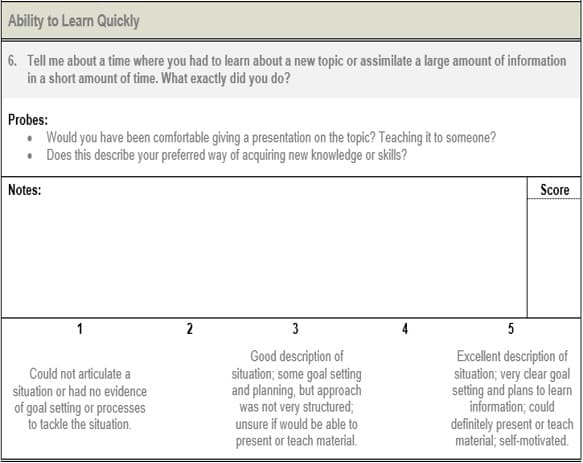 |
Exact question you will ask Place to record score Anchored scale with definitions of a poor, ok and great answer |
Step 4: Assemble an interview team
HR and the direct reporting supervisor should always be part of the interview. Make a good impression with a good interview team.
The must-haves:
- The Future Manager should always be involved in the process. They should be comfortable with the new hire’s competencies and fit.
- Human Resources should always be involved in the process – they maintain consistency, legality, and standardization. It’s their job to know the rules and follow them. HR may coordinate and maintain policy standards and/or join in assessing the candidate.
- There should always be more than just one interviewer, even if it is not at the same time. This helps keep the process objective, allows for different opinions, and gives the interviewee exposure to multiple individuals in the company. But, try to limit the number of panel members to four or less.
“At the end of the day, it’s the supervisor that has to live with the person, so any decision that does not involve the supervisor is a very flawed process.” – VP, Financial Services
The nice-to-haves:
- Future colleagues can offer benefits to both the interviewee and the colleague by:
- Giving the candidate some insight into what their day-to-day job would be.
- Relaxing the candidate; allowing for a less formal, less intimidating conversation.
- Introducing potential teammates for a position that is highly collaborative.
- Offering the interviewer an excellent professional development opportunity – a chance to present their understanding of what they do.
- Executives should take part in interviewing for executive hiring, individuals that will report to an executive, or for positions that are extremely important. Executive time is scarce and expensive, so only use it when absolutely necessary.
Record the interview team details in the Candidate Interview Strategy and Planning Guide template.
Assign interviewers roles inside and outside the actual interview
Define Interview Process Roles
Who Should… Contact candidates to schedule interviews or communicate decisions?
Who Should… Be responsible for candidate welcomes, walk-outs, and hand-offs between interviews?
Who Should… Define and communicate each stakeholder’s role?
Who Should… Chair the preparation and debrief meetings and play the role of the referee when trying to reach a consensus?
Define Interview Roles
- Set a role for each interviewer so they know what to focus on and where they fit into the process (e.g. Interviewer A will assess fit). Don’t ad hoc the process and allow everyone to interview based on their own ideas.
- Consider interviewer qualifications and the impact of the new employee on each interviewer, when deciding the roles of each interviewer (i.e. who will interview for competency and who will interview for fit).
- For example, managers may be most impacted by technical competencies and should be the interviewer to evaluate the candidate for technical competency.
“Unless you’ve got roles within the panel really detailed and agreed upon, for example, who is going to take the lead on what area of questions, you end up with a situation where nobody is in charge or accountable for the final interview assessment." – VP, Financial Services
Info-Tech Insight
Try a Two Lens Assessment: One interviewer assesses the candidate as a project leader while another assesses them as a people leader for a question such as “Give me an example of when you exercised your leadership skills with a junior team member.”
Step 5: Set decision rights in stone and communicate them in advance to manage stakeholder expectations and limit conflict
All interviewers must understand their decision-making authority prior to the interview. Misunderstandings can lead to resentment and conflict.
It is typical and acceptable that you, as the direct reporting manager, should have veto power, as do some executives. |
Veto Power Direct Supervisor or Manager |
Decision Makers: Must Have Consensus Other Stakeholders Direct Supervisor’s Boss Direct Supervisor |
Contributes Opinion HR Representative Peer |
After the preliminary interview, HR should not be involved in making the decision unless they have a solid understanding of the position. Peers can make an unfair assessment due to perceived competition with a candidate. Additionally, if a peer doesn’t want a candidate to be hired and the direct supervisor does hire the candidate, the peer may hold resentment against that candidate and set the team up for conflict. |
The decision should rest on those who will interact with the candidate on a daily basis and who manage the team or department that the candidate will be joining. |
The decisions being made can include whether or not to move a candidate onto the next phase of the hiring process or a final hiring decision. Deciding decision rights in advance defines accountability for an effective interview process.
Create your interview team, assessments, and objective anchor scale
- Download the Behavioral Interview Question Library as a reference.
- On tab 9 of your workbook, document all the members of the team and their respective roles in the interview process. Fill in the decision-making authority section to ensure every team member is held accountable to their assigned tasks and understands how their input will be used.
- For each required attribute in the Ideal Candidate Scorecard, chose one to two questions from the library that can properly evaluate that attribute.
- Copy and paste the questions and probing questions into the Interview Guide Template.
- Create an objective anchor scale and clearly define what a poor, ok, and great answer to each question is.
Download the Behavioral Interview Question Library
| Input | Output |
|
|
| Materials | Participants |
|
|
Conduct an effective, professional, and organized in-person interview
Give candidates a warm, genuine greeting. Introduce them to other interviewers present. Offer a drink. Make small talk. |
“There are some real advantages to creating a comfortable climate for the candidate; the obvious respect for the individual, but people really let their guard down.” – HR Director, Financial Services |
Give the candidate an overview of the process, length, and what to expect of the interview. Indicate to the candidate that notes will be taken during the interview. |
If shorter than an hour, you probably aren’t probing enough or even asking the right questions. It also looks bad to candidates if the interview is over quickly. |
Start with the first question in the interview guide and make notes directly on the interview guide (written or typed) for each question. |
Take lots of notes! You think you’ll remember what was said, but you won’t. It also adds transparency and helps with documentation. |
Ask the questions in the order presented for interview consistency. Probe and clarify as needed (see next slide). |
Keep control of the interview by curtailing any irrelevant or long-winded responses. |
After all interview questions are complete, ask candidates if there was anything about their qualifications that was missed that they want to highlight. |
Lets you know they understand the job and gives them the feeling they’ve put everything on the table. |
Ask if the candidate has any questions. Respond to the questions asked. |
Answer candidate questions honestly because fit works both ways. Ensure candidates leave with a better sense of the job, expectations, and organizational culture. |
Review the compensation structure for the position and provide a realistic preview of the job and organization. |
Provide each candidate with a fair chance by maintaining a consistent interview process. |
Tell interviewees what happens next in the process, the expected time frame, and how they will be informed of the outcome. Escort them out and thank them for the interview. |
The subsequent slides provide additional detail on these eight steps to conducting an effective interview.
Avoid these common biases and mistakes
Common Biases
Like-me effect: An often-unconscious preference for, and unfairly positive evaluation of, a candidate based on shared interests, personalities, and experiences, etc.
Status effect: Overrating candidates based on the prestige of previously held positions, titles, or schools attended.
Recency bias: Placing greater emphasis on interviews held closer to the decision-making date.
Contrast effect: Rating candidates relative to those who precede or follow them during the interview process, rather than against previously determined data.
Solution
Assess candidates by using existing competency-based criteria.
Common Mistakes
Negative tone: Starting the interview on a negative or stressful note may derail an otherwise promising candidate.
Poor interview management: Letting the candidate digress may leave some questions unanswered and reduce the interview value.
Reliance of first impressions: Basing decisions on first impressions undermines the objectivity of competency-based selection.
Failure to ask probing questions: Accepting general answers without asking follow-up questions reduces the evidentiary value of the interview.
Solution
Follow the structured interview process you designed and practiced.
Ask the questions in the order presented in the interview guide, and probe and clarify as needed
Do... |
Don’t… |
|---|---|
Take control of the interview by politely interrupting to clarify points or keep the interviewee on topic. Use probing to drill down on responses and ask for clarification. Ask who, what, when, why, and how. Be cognizant of confidentiality issues. Ask for a sample of work from a past position. Focus on knowledge or information gaps from previous interviews that need to be addressed in the interview. Ensure each member of a panel interview speaks in turn and the lead is given due respect to moderate. |
Be mean when probing. Intimidation actually works against you and is stressful for candidates. When you’re friendly, candidates will actually open up more. Interrupt or undermine other panel members. Their comments and questions are just as valid as yours are, and treating others unprofessionally gives a bad impression to the candidate. Ask illegal questions. Questions about things like religion, disability, and marital and family status are off limits. |
When listening to candidate responses, watch for tone, body language, and red flags
Do... |
While listening to responses, also watch out for red and yellow flags. |
|
Listen to how candidates talk about their previous bosses – you want it to be mainly positive. If their discussion of past bosses reflects a strong sense of self-entitlement or a consistent theme of victimization, this could be a theme in their behavior and make them hard to work with. |
Red Flag A concern about something that would keep you from hiring the person. |
Yellow Flag A concern that needs to be addressed, but wouldn’t keep you from hiring the person. |
Pay attention to body language and tone. They can tell you a lot about candidate motivation and interest. |
↓ |
|
Listen to what candidates want to improve. It’s an opportunity to talk about development and advancement opportunities in the organization. |
Not all candidates have red flags, but it is important to keep them in mind to identify potential issues with the candidate before they are hired. | |
Don’t… |
||
Talk too much! You are there to listen. Candidates should do about 80% of the talking so you can adequately evaluate them. Be friendly, but ensure to spend the time allotted assessing, not chatting. If you talk too much, you may end up hiring a weak candidate because you didn’t perceive weaknesses or not hire a strong candidate because you didn’t identify strengths. |
What if you think you sense a red or yellow flag? Following the interview, immediately discuss the situation with others involved in the recruitment process or those familiar with the position, such as HR, another hiring manager, or a current employee in the role. They can help evaluate if it’s truly a matter of concern. |
|
Increase hiring success: Give candidates a positive perception of the organization in the interview
Great candidates want to work at great organizations.
When the interviewer makes a positive impression on a candidate and provides a positive impression of the organization it carries forward after they are hired.
In addition, better candidates can be referred over the course of time due to higher quality networking.
As much as choosing the right candidate is important to you, make sure the right candidate wants to choose you and work for your organization.
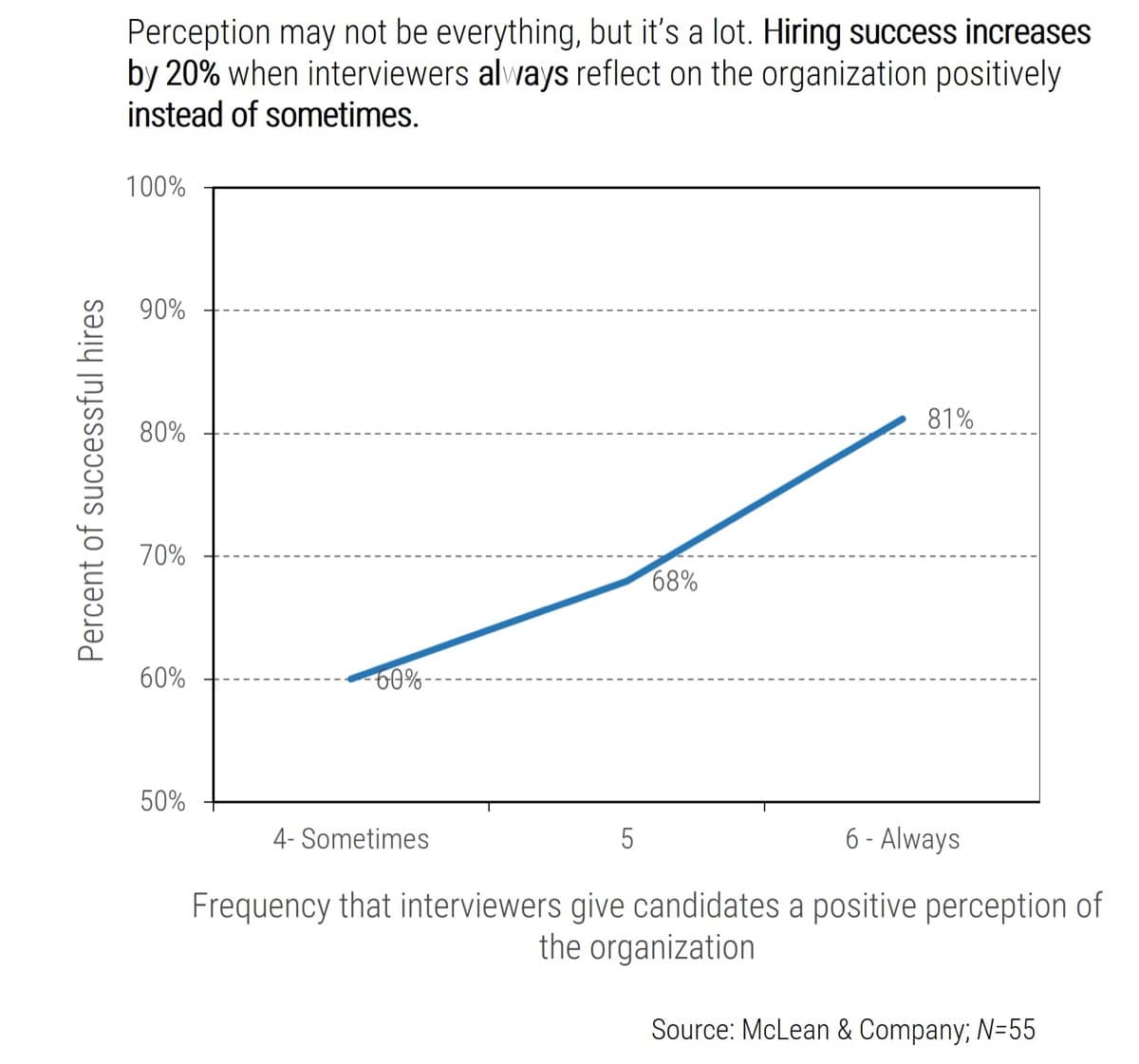
Interview advice seems like common sense, but it’s often not heeded, resulting in poor interviews
Don’t…
Believe everything candidates say. Most candidates embellish and exaggerate to find the answers they think you want. Use probing to drill down to specifics and take them off their game. |
Ask gimmicky questions like “what color is your soul?” Responses to these questions won’t give you any information about the job. Candidates don’t like them either! |
Focus too much on the resume. If the candidate is smart, they’ve tailored it to match the job posting, so of course the person sounds perfect for the job. Read it in advance, highlight specific things you want to ask, then ignore it. |
Oversell the job or organization. Obviously you want to give candidates a positive impression, but don’t go overboard because this could lead to unhappy hires who don’t receive what you sold them. Candidates need to evaluate fit just as much as you. |
Get distracted by a candidate’s qualifications and focus only on their ability to do the job. Just because they are qualified does not mean they have the attitude or personality to fit the job or culture. |
Show emotion at any physical handicap. You can’t discriminate based on physical disability, so protect the organization by not drawing attention to it. Even if you don’t say anything, your facial expression may. |
Bring a bad day or excess baggage into the interview, or be abrupt, rushed, or uninterested in the interview. This is rude behavior and will leave a negative impression with candidates, which could impact your chances of hiring them. |
Submit to first impression bias because you’ll spend the rest of the interview trying to validate your first impression, wasting your time and the candidate’s. Remain as objective as possible and stick to the interview guide to stay focused on the task at hand. |
“To the candidate, if you are meeting person #3 and you’re hearing questions that person #1 and #2 asked, the company doesn’t look too hot or organized.” – President, Recruiting Firm
Practice behavioral interviews
- In groups of at least three:
- Assign one person to act as the manager conducting the interview, a second person to act as the candidate, and a third to observe.
- The observer will provide feedback to the manager at the end of the role play based on the information you just learned.
- Observers – please give feedback on the probing questions and body language.
- How did it go?
- Were you able to get the candidate to speak in specifics rather than generalities? What tips do you have for others?
- What didn’t go so well? Any surprises?
- What would you do differently next time?
- If this was a real hiring situation, would the information you got from just that one question help you make a hiring decision for the role?
| Input | Output |
|
|
| Materials | Participants |
|
|
Download the Behavioral Interview Question Library
Record best practices, effective questions, and candidate insights for future use and current strategy
Results and insights gained from evaluations need to be recorded and assessed to gain value from them going forward.
- To optimize evaluation, all feedback should be forwarded to a central point so that the information can be shared with all stakeholders. HR can serve in this role.
- Peer evaluations should be shared shortly after the interview. Immediate feedback that represents all the positive and negative responses is instructional for interviewers to consider right away.
- HR can take a proactive approach to sharing information and analyzing and improving the interview process in order to collaborate with hiring departments for better talent management.
- Collecting information about effective and ineffective interview questions will guide future interview revision and development efforts.
Evaluations Can Inform Strategic Planning and Professional Development
Strategic Planning
- Survey data can be used to inform strategic planning initiatives in recruiting.
- Use the information to build a case to the executive team for training, public relations initiatives, or better candidate management systems.
Professional Development
- Survey data from all evaluations should be used to inform future professional development initiatives.
- Interview areas where all team members show weaknesses should be training priorities.
- Individual weaknesses should be integrated into each professional development plan.
Want to learn more?
Recruit IT Talent
- Improve candidate experience to hire top IT talent.
Recruit and Retain More Women in IT
- Gender diversity is directly correlated to IT performance.
Recruit and Retain People of Color in IT
- Good business, not just good philanthropy.
Develop a Comprehensive Onboarding Plan
Drive employee engagement and retention with a robust program that acclimates, guides, and develops new hires.
Onboarding should pick up where candidate experience leaves off
Do not confuse onboarding with orientation
Onboarding ≠ Orientation
Onboarding is more than just orientation. Orientation is typically a few days of completing paperwork, reading manuals, and learning about the company’s history, strategic goals, and culture. By contrast, onboarding is three to twelve months dedicated to welcoming, acclimating, guiding, and developing new employees – with the ideal duration reflecting the time to productivity for the role.
A traditional orientation approach provides insufficient focus on the organizational identification, socialization, and job clarity that a new hire requires. This is a missed opportunity to build engagement, drive productivity, and increase organizational commitment. This can result in early disengagement and premature departure.
Effective onboarding positively impacts the organization and bottom line
Over the long term, effective onboarding has a positive impact on revenue and decreases costs.
The benefits of onboarding:
- Save money and frustration
- Shorten processing time, reduce administrative costs, and improve compliance.
- Boost revenue
- Help new employees become productive faster – also reduce the strain on existing employees who would normally be overseeing them or covering a performance shortfall.
- Drive engagement and reduce turnover
- Quickly acclimate new hires to your organization’s environment, culture, and values.
- Reinforce culture and employer brand
- Ensure that new hires feel a connection to the organization’s culture.
Onboarding drives new hire engagement from day one
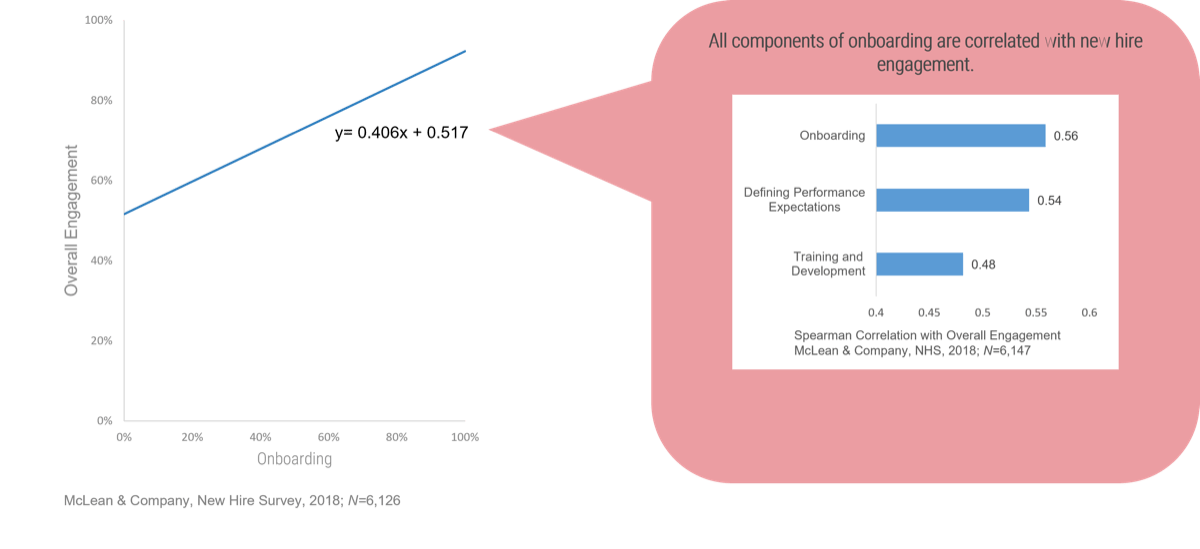
When building an onboarding program, retain the core aims: acclimate, guide, and develop
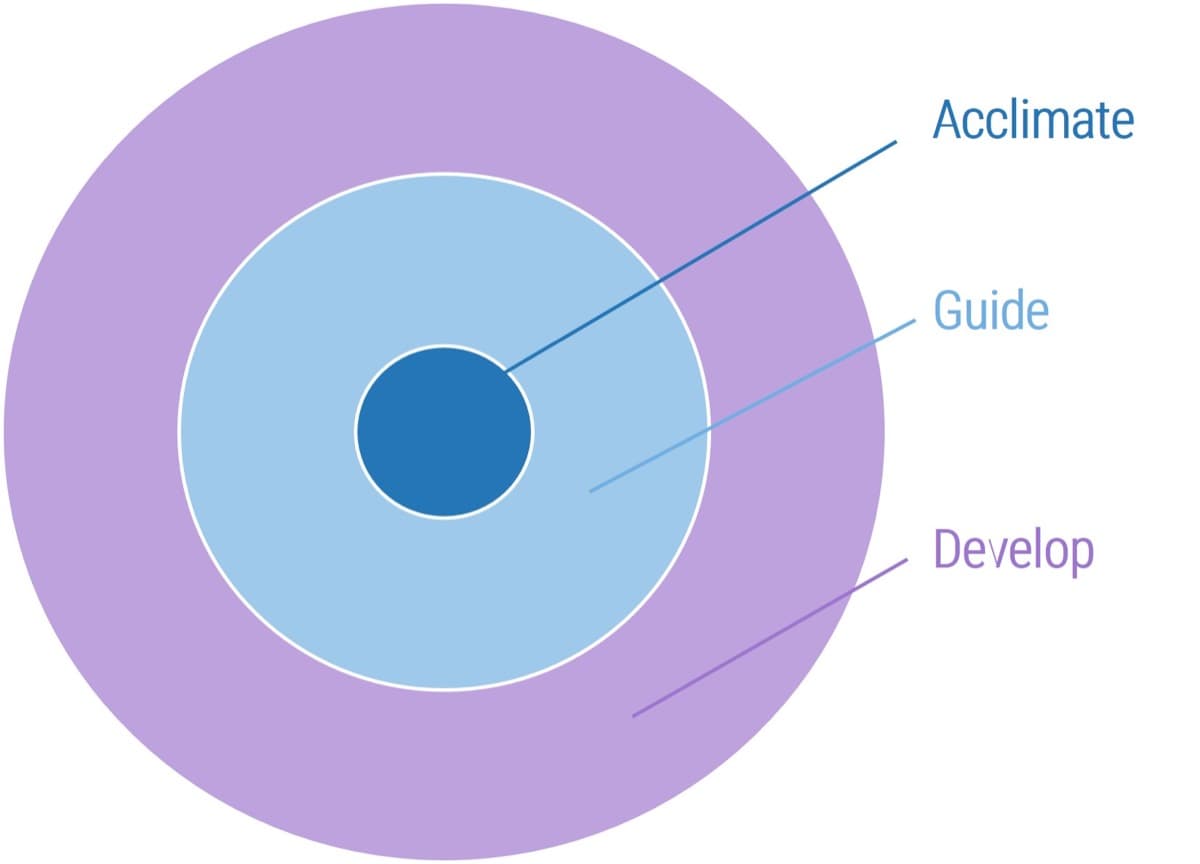
Help new hires feel connected to the organization by clearly articulating the mission, vision, values, and what the company does. Help them understand the business model, the industry, and who their competitors are. Help them feel connected to their new team members by providing opportunities for socialization and a support network. |
Help put new hires on the path to high performance by clearly outlining their role in the organization and how their performance will be evaluated. |
Help new hires receive the experience and training they require to become high performers by helping them build needed competencies. |
We recommend a three-to-twelve-month onboarding program, with the performance management aspect of onboarding extending out to meet the standard organizational performance management cycle.
Info-Tech Insight
The length of the onboarding program should align with the average time to productivity for the role(s). Consider the complexity of the role, the industry, and the level of the new hire when determining program length.
For example, call center workers who are selling a straight-forward product may only require a three-month onboarding, while senior leaders may require a year-long program.
Watch for signs that you aren’t effectively acclimating, guiding, and developing new hires
Our primary and secondary research identified the following as the most commonly stated reasons why employees leave organizations prematurely. These issues will be addressed throughout the next section.
Acclimate |
Guide |
Develop |
|
|
|
“Onboarding is often seen as an entry-level HR function. It needs to rise in importance because it’s the first impression of the organization and can be much more powerful than we sometimes give it credit for. It should be a culture building and branding program.” – Doris Sims, SPHR, The Succession Consultant, and Author, Creative Onboarding Programs
Use the onboarding tabs in the workbook to evaluate and redesign the onboarding program
- On tab 10, brainstorm challenges that face the organization's current onboarding program. Identify if they fall into the "acclimate," "guide," or "develop" category. Next, record the potential impact of this challenge on the overall effectiveness of the onboarding program.
- On tab 11, record each existing onboarding activity. Then, identify if that activity will be kept or if it should be retired. Next, document if the activity fell into the "acclimate," "guide," or "develop" category.
- On tab 12, document gaps that currently exist in the onboarding program. Modify the timeline along the side of the tab to ensure it reflects the timeline you have identified.
- On tab 13, document the activities that will occur in the new onboarding program. This should be a combination of current activities that you want to retain and new activities that will be added to address the gaps noted on tab 12. For each activity, identify if it will fall in the acclimate, guide, or develop section. Add any additional notes. Before moving on, make sure that there are no categories that have no activities (e.g. no guide activities).
| Input | Output |
|
|
| Materials | Participants |
|
|
Review the administrative aspects of onboarding and determine how to address the challenges
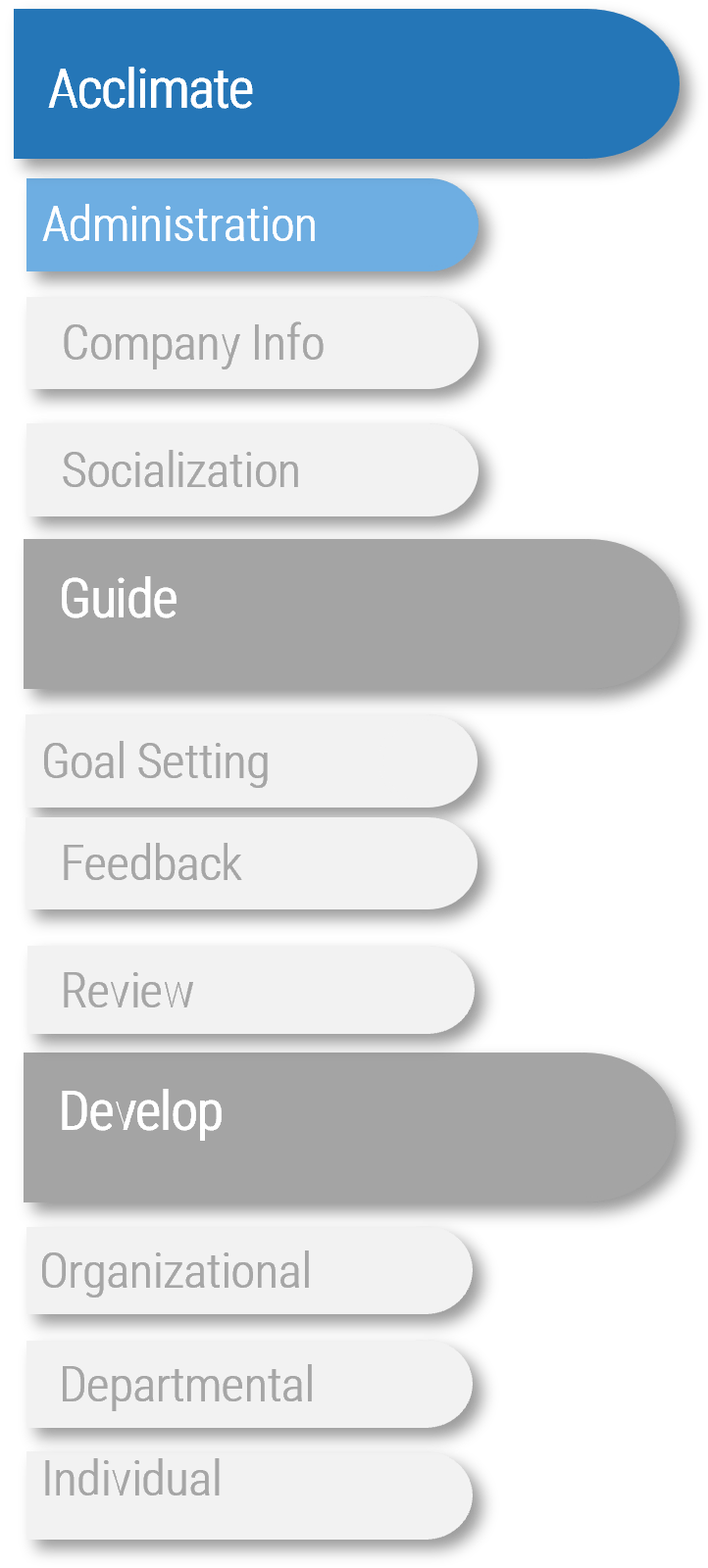 |
Sample challenges |
Potential solutions |
|---|---|---|
Some paperwork cannot be completed digitally (e.g. I-9 form in the US). |
Where possible, complete forms with digital signatures (e.g. DocuSign). Where not possible, begin the process earlier and mail required forms to employees to sign and return, or scan and email for the employee to print and return. |
|
Required compliance training material is not available virtually. |
Seek online training options where possible. Determine the most-critical training needs and prioritize the replication of materials in audio/video format (e.g. recorded lecture) and distribute virtually. |
|
Employees may not have access to their equipment immediately due to shipping or supply issues. |
Delay employee start dates until you can set them up with the proper equipment and access needed to do their job. |
|
New hires can’t get answers to their questions about benefits information and setup. |
Schedule a meeting with an HR representative or benefits vendor to explain how benefits will work and how to navigate employee self-service or other tools and resources related to their benefits. |
Info-Tech Insight
One of the biggest challenges for remote new hires is the inability to casually ask questions or have conversations without feeling like they’re interrupting. Until they have a chance to get settled, providing formal opportunities for questions can help address this.
Review how company information is shared during onboarding and how to address the challenges
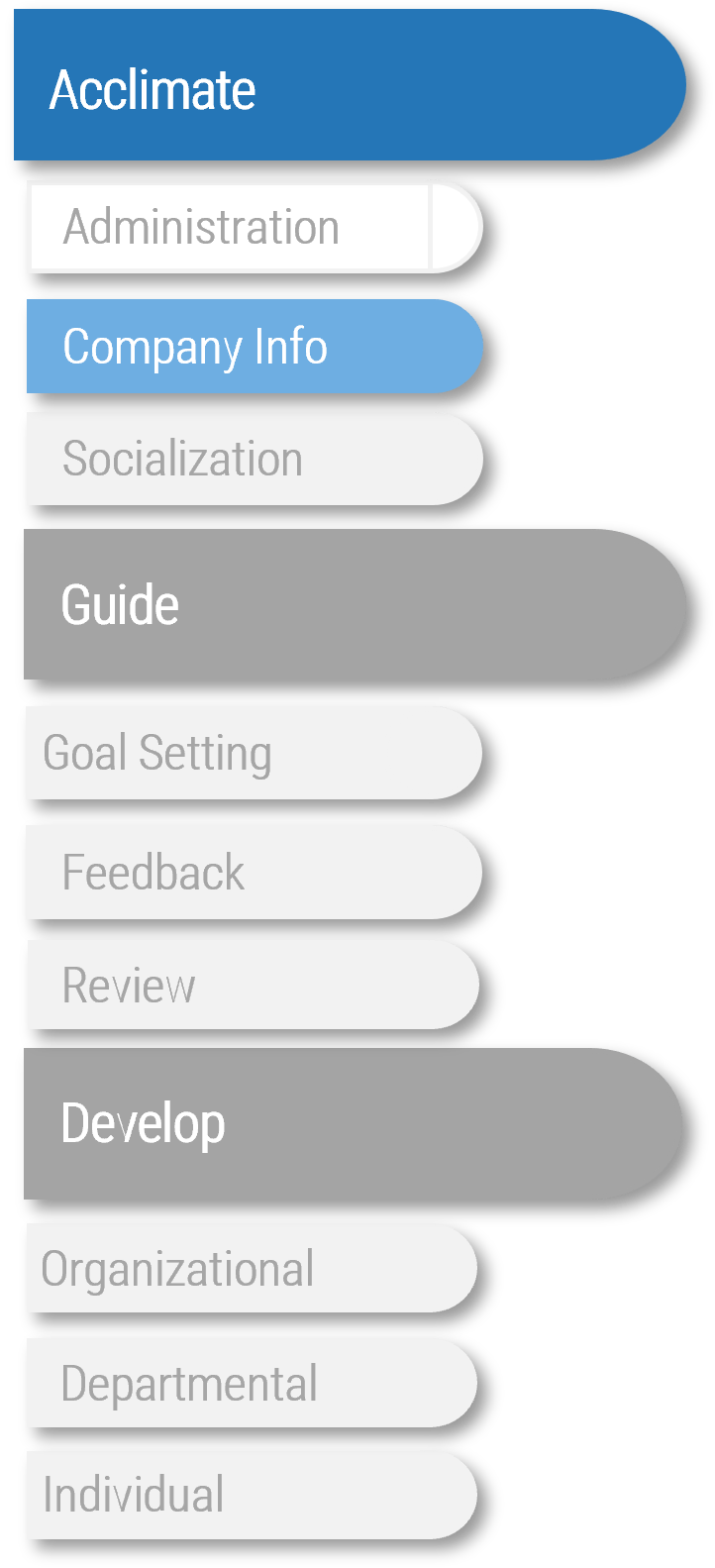 | Sample challenges | Potential solutions |
|---|---|---|
Key company information such as organizational history, charts, or the vision, mission, and values cannot be clearly learned by employees on their own. | Have the new hire’s manager call to walk through the important company information to provide a personal touch and allow the new hire to ask questions and get to know their new manager. | |
Keeping new hires up to date on crisis communications is important, but too much information may overwhelm them or cause unnecessary stress. | Sharing the future of the organization is a critical part of the company information stage of onboarding and the ever-changing nature of the COVID-19 crisis is informing many organizations’ future right now. Be honest but avoid over-sharing plans that may change. | |
New hires can’t get answers to their questions about benefits information and setup. | Schedule a meeting with an HR representative or benefits vendor to explain how benefits will work and how to navigate employee self-service or other tools and resources related to their benefits. |
Review the socialization aspects of onboarding and determine how to address the challenges
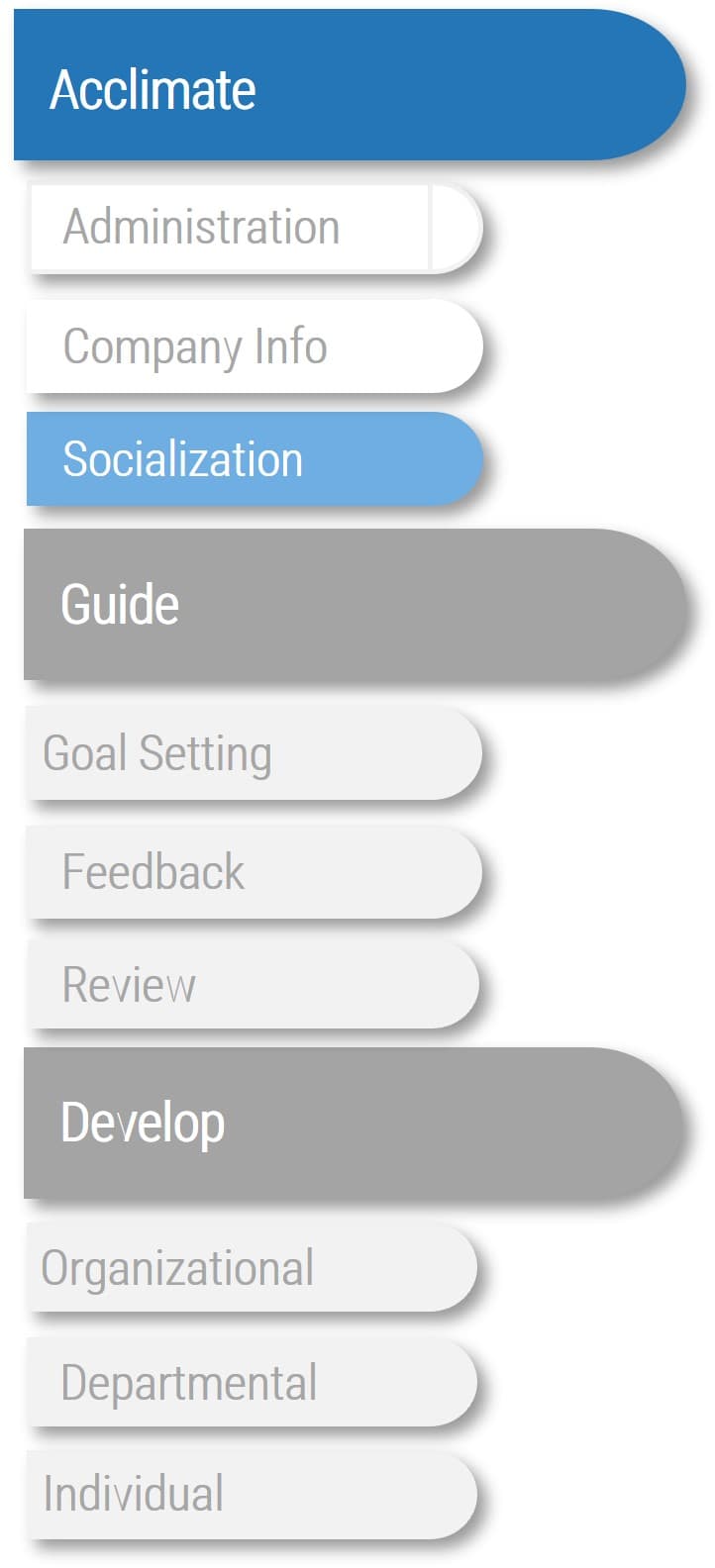 | Sample challenges | Potential solutions |
|---|---|---|
Team introductions via a team lunch or welcome event are typically done in person. | Provide managers with a calendar of typical socialization events in the first few weeks of onboarding and provide instructions and ideas for how to schedule replacement events over videoconferencing. | |
New hires may not have a point of contact for informal questions or needs if their peers aren’t around them to help. | If it doesn’t already exist, create a virtual buddy program and provide instructions for managers to select a buddy from the new hire’s team. Explain that their role is to field informal questions about the company, team, and anything else and that they should book weekly meetings with the new hire to stay in touch. | |
New hires will not have an opportunity to learn or become a part of the informal decision-making networks at the organization. | Hiring managers should consider key network connections that new hires will need by going through their own internal network and asking other team members for recommendations. | |
New hires will not be able to casually meet people around the office. | Provide the employee with a list of key contacts for them to reach out to and book informal virtual coffee chats to introduce themselves. |
Adapt the Guide phase of onboarding to a virtual environment
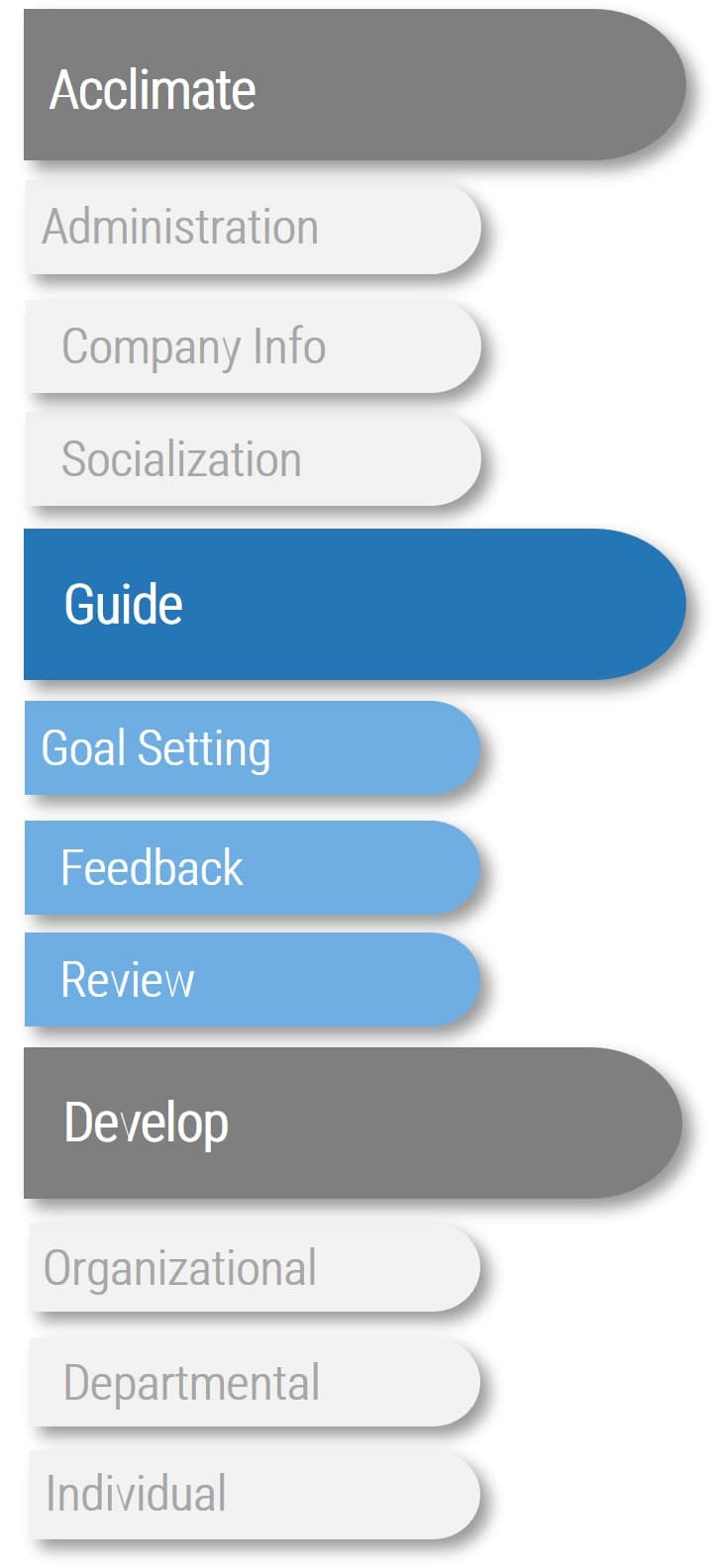 | Sample challenges | Potential solutions |
|---|---|---|
Performance management (PM) processes have been paused given the current crisis. | Communicate to managers that new hires still need to be onboarded to the organization’s performance management process and that goals and feedback need to be introduced and the review process outlined even if it’s not currently happening. | |
Goals and expectations differ or have been reprioritized during the crisis. | Ask managers to explain the current situation at the organization and any temporary changes to goals and expectations as a result of new hires. | |
Remote workers often require more-frequent feedback than is mandated in current PM processes. | Revamp PM processes to include daily or bi-weekly touchpoints for managers to provide feedback and coaching for new hires for at least their first six months. | |
Managers will not be able to monitor new hire work as effectively as usual. | Ensure there is a formal approach for how employees will keep their managers updated on what they're working on and how it's going, for example, daily scrums or task-tracking software. |
For more information on adapting performance management to a virtual environment, see Info-Tech’s Performance Management for Emergency Work-From-Home research.
Take an inventory of training and development in the onboarding process and select critical activities
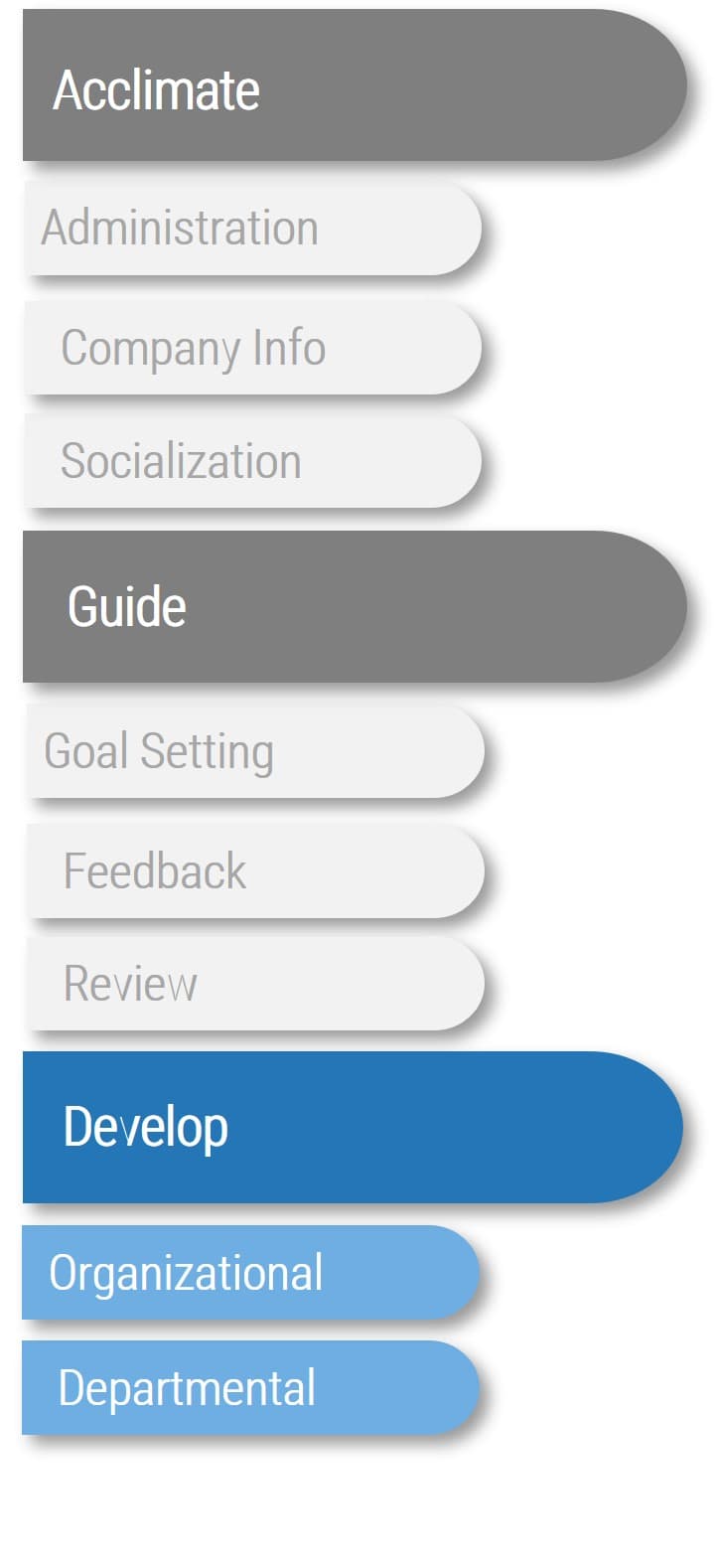
Categorize the different types of formal and informal training in the onboarding process into the following three categories. For departmental and individual training, speak to managers to understand what is required on a department and role basis:
Organizational |
Departmental |
Individual |
|---|---|---|
For example:
|
For example:
|
For example:
|
In a crisis, not every training can be translated to a virtual environment in the short term. It’s also important to focus on critical learning activities versus the non-critical. Prioritize the training activities by examining the learning outcomes of each and asking:
- What organizational training does every employee need to be a productive member of the organization?
- What departmental or individual training do new hires need to be successful in their role?
Lower priority or non-critical activities can be used to fill gaps in onboarding schedules or as extra activities to be completed if the new hire finds themselves with unexpected downtime to fill.
Determine how onboarding training will be delivered virtually

Who will facilitate virtual training sessions?
- For large onboarding cohorts, consider live delivery via web conferencing where possible. This will create a more engaging training program and will allow new hires to interact with and ask questions of the presenter.
- For individual new hires or small cohorts, have senior leaders or key personnel from across the organization record different trainings that are relevant for their role.
- For example, training sessions about organizational culture can be delivered by the CEO or other senior leader, while sales training could be delivered by a sales executive.
If there is a lack of resources, expertise, or time, outsource digital training to a content provider or through your LMS.
What existing or free tools can be leveraged to immediately support digital training?
- Laptops and PowerPoint to record training sessions that are typically delivered in-person
- YouTube/Vimeo to host recorded lecture-format training
- Company intranet to host links and files needed to complete training
- Web conferencing software to host live training/orientation sessions (e.g. Webex)
- LMS to host and track completion of learning content
Want to learn more?
Recruit IT Talent
- Improve candidate experience to hire top IT talent.
Recruit and Retain More Women in IT
- Gender diversity is directly correlated to IT performance.
Recruit and Retain People of Color in IT
- Good business, not just good philanthropy.
Adapt Your Onboarding Process to a Virtual Environment
- Develop short-term solutions with a long-term outlook to quickly bring in new talent.
Bibliography
2021 Recruiter Nation Report. Survey Analysis, Jobvite, 2021. Web.
“5 Global Stats Shaping Recruiting Trends.” The Undercover Recruiter, 2022. Web.
Barr, Tavis, Raicho Bojilov, and Lalith Munasinghe. "Referrals and Search Efficiency: Who Learns What and When?" The University of Chicago Press, Journal of Labor Economics, vol. 37, no. 4, Oct. 2019. Web.
“How to grow your team better, faster with an employee referral program.” Betterup, 10 Jan. 2022. Web.
“Employee Value Proposition: How 25 Companies Define Their EVP.” Built In, 2021. Web.
Global Leadership Forecast 2021. Survey Report, DDI World, 2021. Web.
“Connecting Unemployed Youth with Organizations That Need Talent.” Harvard Business Review, 3 November 2016. Web.
Ku, Daniel. “Social Recruiting: Everything You Need To Know for 2022.” PostBeyond, 26 November 2021. Web.
Ladders Staff. “Shedding light on the job search.” Ladders, 20 May 2013. Web.
Merin. “Campus Recruitment – Meaning, Benefits & Challenges.” HR Shelf, 1 February 2022. Web.
Mobile Recruiting. Smart Recruiters, 2020. Accessed March 2022.
Roddy, Seamus. “5 Employee Referral Program Strategies to Hire Top Talent.” Clutch, 22 April 2020. Web.
Sinclair, James. “What The F*dge: That's Your Stranger Recruiting Budget?” LinkedIn, 11 November 2019. Web.
“Ten Employer Examples of EVPs.” Workology, 2022. Web
“The Higher Cost of a Bad Hire.” Robert Half, 15 March 2021. Accessed March 2022.
Trost, Katy. “Hiring with a 90% Success Rate.” Katy Trost, Medium, 8 August 2022. Web.
“Using Social Media for Talent Acquisition.” SHRM, 20 Sept. 2017. Web.